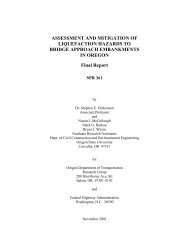Oregon Balance of State HIV/AIDS Housing & Services Systems ...
Oregon Balance of State HIV/AIDS Housing & Services Systems ...
Oregon Balance of State HIV/AIDS Housing & Services Systems ...
Create successful ePaper yourself
Turn your PDF publications into a flip-book with our unique Google optimized e-Paper software.
<strong>Oregon</strong> <strong>HIV</strong>/<strong>AIDS</strong> <strong>Housing</strong> and <strong>Services</strong> <strong>Systems</strong> Integration Plan—Appendices A-61<br />
HOUSING QUALITY STANDARDS (HQS) Standards set by the U.S. Department <strong>of</strong> <strong>Housing</strong> and Urban<br />
Development (HUD) to ensure that all housing receiving HUD financial assistance meets a certain level <strong>of</strong><br />
quality. HQS requires that recipients <strong>of</strong> HUD funding provide safe and sanitary housing that is in compliance<br />
with state and local housing codes, licensing requirements, and any other jurisdiction-specific housing<br />
requirements.<br />
HRSA Health Resources and <strong>Services</strong> Administration. HRSA is an agency <strong>of</strong> the U.S. Department <strong>of</strong> Health<br />
and Human <strong>Services</strong> that works toward providing health care to low-income, uninsured, isolated, vulnerable,<br />
and special needs populations through a number <strong>of</strong> programs including the Ryan White CARE Act, Rural<br />
Health Initiative, and other community-based health initiatives. (See Ryan White CARE Act)<br />
HUD U.S. Department <strong>of</strong> <strong>Housing</strong> and Urban Development. HUD is a cabinet-level agency designed to<br />
advocate for the housing needs <strong>of</strong> people with low incomes through programs for public housing, special<br />
needs housing, and first time homebuyers.<br />
INFORMATION AND REFERRAL Non-monetary assistance to individuals who are having a difficult time<br />
finding and/or securing housing.<br />
LOW-INCOME FAMILY Family whose income does not exceed 50 percent <strong>of</strong> the median family income (MFI)<br />
for the area, as determined by the U.S. Department <strong>of</strong> <strong>Housing</strong> and Urban Development (HUD), with<br />
adjustments for smaller and larger families. HUD may establish income ceilings higher or lower than 50<br />
percent <strong>of</strong> the median for the area on the basis <strong>of</strong> findings that such variations are necessary because <strong>of</strong><br />
prevailing levels <strong>of</strong> construction costs or Fair Market Rents, or unusually high or low family incomes.<br />
LOW INCOME HOUSING TAX CREDIT PROGRAM Formula allotment <strong>of</strong> federal income tax credits<br />
administered by states and distributed to nonpr<strong>of</strong>it and for-pr<strong>of</strong>it developers <strong>of</strong> and investors in low-income<br />
rental housing to encourage capacity development. Since its creation in 1986 by the Tax Reform Act, more<br />
than a million units have been funded nationwide, utilizing the equivalent <strong>of</strong> more than $7.5 billion dollars in<br />
funding annually.<br />
MAINSTREAM PROGRAM See <strong>Housing</strong> Choice Voucher (HCV) Program.<br />
MASTER LEASING A housing strategy in which a sponsor agency leases housing units from private or<br />
nonpr<strong>of</strong>it housing landlords and subleases the units to individuals and families that meet the sponsor<br />
agency’s eligibility criteria. This housing option is used mainly as transitional housing. In a transitional<br />
housing master leasing scenario, subleases with individuals and families can include stipulations for duration<br />
<strong>of</strong> tenancy and responsibilities <strong>of</strong> tenancy, such as a requirement to participate in support services. Master<br />
Leasing can be an alternative for landlords, since the sponsor agency absorbs some portion <strong>of</strong> the risk and<br />
responsibility for hard-to-house clients.<br />
MCKINNEY-VENTO ACT The primary federal response targeted to assisting homeless individuals and<br />
families. The scope <strong>of</strong> the Act includes: outreach, emergency food and shelter, transitional and permanent<br />
housing, primary health care services, mental health, alcohol and drug abuse treatment, education, job<br />
training, and child care. There are nine titles under the McKinney-Vento Act that are administered by several<br />
different federal agencies, including the U.S. Department <strong>of</strong> <strong>Housing</strong> and Urban Development (HUD).<br />
McKinney-Vento Act Programs administered by HUD include: Emergency Shelter Grant Program,<br />
Supportive <strong>Housing</strong> Program, Section 8 Moderate Rehabilitation for Single-Room Occupancy Dwellings,<br />
Supplemental Assistance to Facilities to Assist the Homeless, and Single Family Property Disposition<br />
Initiative. Also see: Emergency Shelter Grants, Federal Emergency Management Administration, Shelter<br />
Plus Care, Section 8 Moderate Rehabilitation for Single-Room Occupancy Dwellings, and Supportive<br />
<strong>Housing</strong> Program.

















